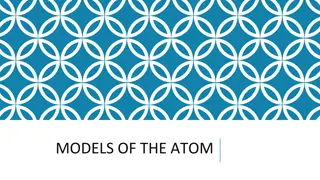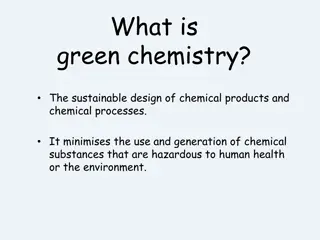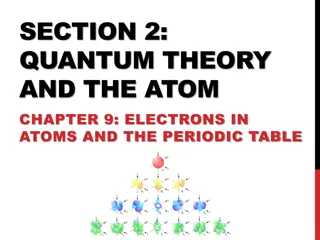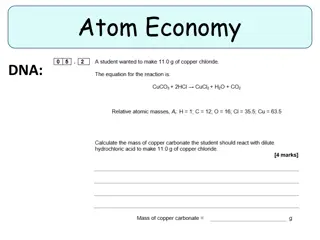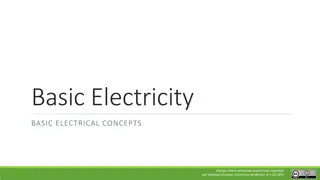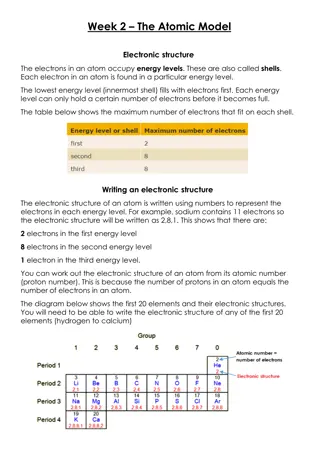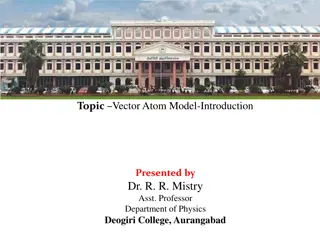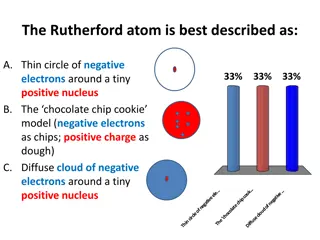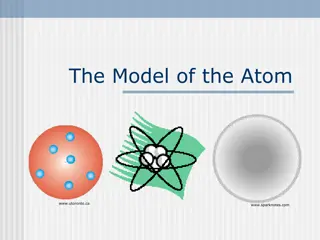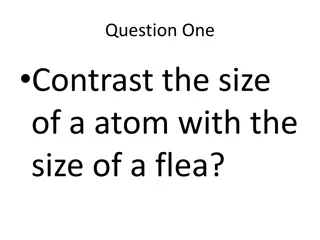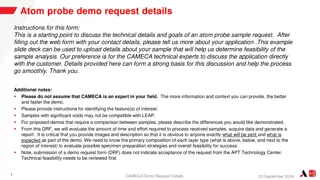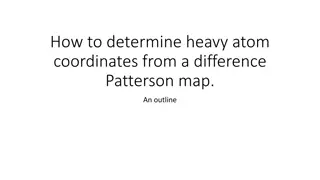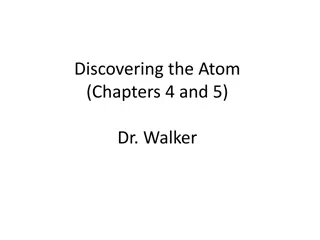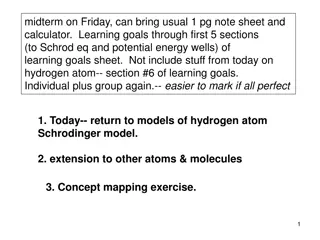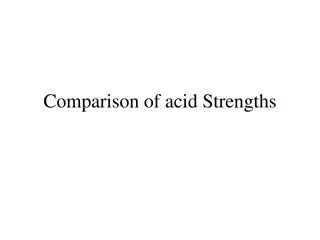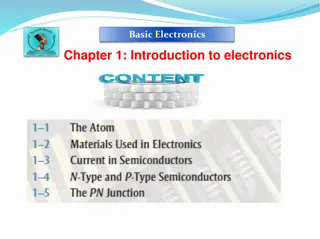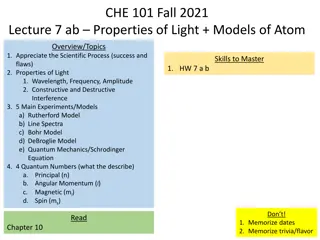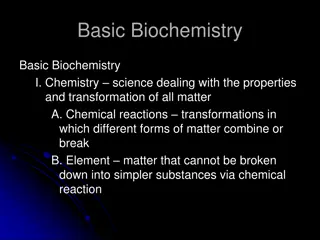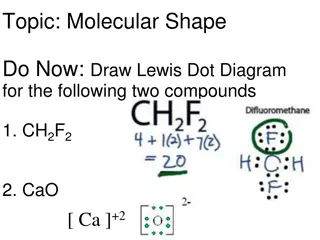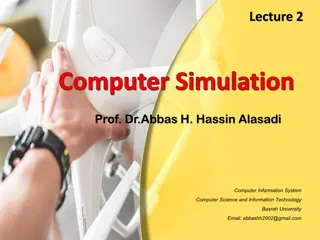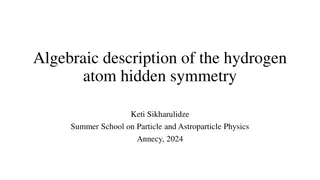System Models in Software Engineering: A Comprehensive Overview
System models play a crucial role in software engineering, aiding in understanding system functionality and communicating with customers. They include context models, behavioural models, data models, object models, and more, each offering unique perspectives on the system. Different types of system
7 views • 33 slides
Models of the Atom: Nucleus, Protons, Electrons
Dive into the fundamental concepts of atoms, exploring their structure with a focus on the nucleus, protons, electrons, and neutrons. Discover how the periodic table reveals crucial information about elements, such as atomic number and mass number. Explore the evolution of atom models and the necess
5 views • 20 slides
Green Chemistry Principles and Efficiency in Chemical Processes
Green chemistry focuses on designing sustainable chemical products and processes to minimize hazardous substances. It advocates for waste prevention, efficient reactions, and use of raw materials. Chemical engineers play a key role in optimizing percentage yield and atom economy for efficient produc
2 views • 49 slides
Models of Teaching for Effective Learning
Models of teaching serve as instructional designs to facilitate students in acquiring knowledge, skills, and values by creating specific learning environments. Bruce Joyce and Marsha Weil classified teaching models into four families: Information Processing Models, Personal Models, Social Interactio
5 views • 28 slides
Quantum Theory and the Atom: Electrons in Atoms and the Periodic Table
Delve into the fascinating world of quantum theory and the atom in Chapter 9, where we compare Bohr's model with the quantum mechanical model. Understand de Broglie's wave-particle duality and Heisenberg's uncertainty principle's impact on our current electron view. Discover the relationships among
3 views • 31 slides
Atom Economy in Chemical Reactions
Explore the concept of atom economy in chemistry, learn how to calculate atom economy of a reaction, and understand why it is important for industrial processes. Watch a video, answer questions, and practice with worked examples and self-assessment tasks to grasp the significance of efficient indust
30 views • 21 slides
Parts of the Atom: A Visual Journey
Delve into the discovery of the constituents of an atom, from the negatively charged particles in the electron cloud to the positively charged particles in the nucleus. Learn about protons, neutrons, and the particle with no charge as they form the building blocks of matter. Engage with visually sti
9 views • 17 slides
Basic Electrical Concepts
Delve into the fundamentals of electricity, covering atom structure, electrical materials, direct and alternating currents, and more. Gain insights into key terms and definitions essential for basic circuit analysis. Explore the significance of atom charges, materials conductivity, and the role of p
0 views • 21 slides
Atomic Structure: Electrons, Energy Levels, and Historical Models
The atomic model describes how electrons occupy energy levels or shells in an atom. These energy levels have specific capacities for electrons. The electronic structure of an atom is represented by numbers indicating electron distribution. Over time, scientists have developed atomic models based on
5 views • 5 slides
Exploring the Vector Atom Model in Quantum Physics
Delve into the Vector Atom Model as presented by Dr. R. R. Mistry, discussing the quantum numbers, coupling, exclusion principles, and effects like Zeeman and Stark. Learn how this model explains complex atomic spectra and spatial quantization, offering a deeper understanding of atomic structures.
6 views • 11 slides
The Rutherford Atom and Its Structure
The Rutherford atom is characterized by a thin circle of negative electrons surrounding a tiny positive nucleus. In this model, the electrons are in a diffuse cloud around the nucleus, forming the majority of the atomic volume but only a small fraction of the mass. Protons define an element's atomic
3 views • 17 slides
Evolution of Atomic Models: From Thomson to Bohr
Scientists from J.J. Thomson to Niels Bohr made groundbreaking discoveries in understanding the structure of the atom. Thomson's plum-pudding model was followed by Rutherford's nuclear model, revealing the nucleus. Bohr introduced the concept of discrete energy levels and orbits for electrons. These
8 views • 22 slides
Atom Structure and Properties Questions
This series of questions delves into the intriguing world of atoms, covering topics such as atom size comparison, proton count identification, location of metals on the Periodic Table, nucleus charge explanation, atomic number significance, various arrangements of the Periodic Table, subatomic parti
1 views • 12 slides
Limits on Dark Energy Using Atom Interferometry - UC Berkeley Study
Research conducted by Paul Hamilton Müller's group at the University of California, Berkeley, focuses on using atom interferometry to explore dark energy. The study delves into screened scalar fields as dark energy, future reach with atom interferometry, known unknowns related to dark energy densit
6 views • 39 slides
Atom Probe Sample Request Details and Instructions
This detailed guide provides instructions and recommendations for submitting a sample request for atom probe analysis. It includes information on how to describe the sample, provide images, and outline the goals of the analysis. By following these guidelines, customers can facilitate discussions wit
4 views • 5 slides
Deciphering Heavy Atom Coordinates from Difference Patterson Map: An Overview
Understanding how to determine heavy atom coordinates from a difference Patterson map involves recognizing the relationship between Patterson peak coordinates (u,v,w) and space group symmetry operators in crystallography. By solving equations that relate these coordinates, the absolute positions of
5 views • 5 slides
Evolution of Atomic Theory: From Democritus to Thomson
Examine the evolution of atomic theory through the contributions of key scientists such as Democritus, Dalton, and Thomson. Explore the concept of subatomic particles, different models of the atom, and the impact of experiments on our understanding of the atom over time. From the solid sphere model
4 views • 33 slides
Evolution of Atomic Models: From Rutherford to Quantum Mechanics
Various atomic models have been proposed throughout history, starting with John Dalton's idea of atoms as tiny particles to J.J. Thomson's Plum Pudding model. Ernest Rutherford's discovery of the nucleus and Niels Bohr's quantum model of the atom revolutionized our understanding. Bohr's proposal of
4 views • 38 slides
Quantum Chemistry Learning Goals and Concepts
This content covers the learning goals and concepts of quantum chemistry leading up to the Schrodinger equation and potential energy wells, excluding the material on the hydrogen atom introduced later. It explores models of the atom, including observations of atomic spectra, the Bohr model, de Brogl
4 views • 22 slides
Factors Affecting Acid Strength: Atoms, Size, Hybridization, and Electronegativity
The strength of acids is influenced by various factors such as the atom on which the negative charge of the acid's conjugate base rests, atom size, hybridization, and electronegativity. The stability of negative charges on atoms, atom size allowing charge delocalization, preferred orbital types for
5 views • 23 slides
The Basics of Atom Structure in Electronics
Learn about the fundamental concepts of atom structure in electronics, including the components of atoms, the Bohr model, electron orbits, energy levels, valence electrons, and more. Understanding these principles is essential for grasping the underlying mechanisms of electronic devices.
2 views • 18 slides
Properties of Light and Models of the Atom in Chemistry
Delve into the fascinating world of light properties and atom models in chemistry. Unravel the scientific process, from successes to flaws, and master concepts like wavelength, frequency, and amplitude. Explore key experiments and models such as the Rutherford, Bohr, and DeBroglie models, as well as
1 views • 24 slides
Basic Biochemistry: Matter, Elements, and Atom Structure
Basic Biochemistry explores the science of matter, chemical reactions, elements, and atom structure. It covers the properties and transformations of matter, the significance of essential elements for life, and the structure of atoms including protons, neutrons, and electrons. This foundational knowl
4 views • 50 slides
Atomic Structure and the Elements Overview
The atom, composed of a nucleus and electrons, forms the basis of all matter. Elements, grouped in families on the Periodic Table, exhibit similarities and differences based on their atomic structures. The arrangement of electrons in orbits determines an atom's chemical properties and reactivity. By
1 views • 11 slides
Topic: Molecular Shape
Explore the relationship between Lewis structures and molecular shapes, with a focus on factors influencing molecular geometry such as electron pairs and atoms around the central atom. Utilize VSEPR theory to predict shapes based on electron-pair repulsion. Understand how different atom arrangements
12 views • 22 slides
Computer Simulation Models Classification
Computer simulation models are classified based on various characteristics such as static or dynamic, deterministic or stochastic, and discrete or continuous. Static models represent systems at a specific point in time, while dynamic models depict changes over time. Deterministic models involve no r
4 views • 8 slides
Introduction to Alcohols: Structure and Properties
Alcohols are essential molecules in organic chemistry, characterized by the hydroxyl group (-OH) attached to a carbon atom. They are classified as primary, secondary, or tertiary based on the carbon atom's alkyl group attachments. Alcohols vary in solubility, vapor pressure, and physical properties
5 views • 24 slides
Bohr's Model of Atom and U.Nithya - M.Sc., M.Phil.
In this educational presentation about Bohr's model of the atom, U.Nithya, an experienced instructor with M.Sc. and M.Phil. qualifications, provides comprehensive insights through a series of informative slides. Delve into the world of atomic structure, electrons, and energy levels with detailed exp
2 views • 40 slides
Algebraic Description of Hydrogen Atom Hidden Symmetry and Energy Spectrum Formula
Delve into the fascinating world of the hydrogen atom’s hidden symmetry and the derivation of its energy spectrum formula through solving Schrödinger's differential equation. Uncover the connection between accidental degeneracy and hidden symmetries, brought to light by Pauli. Explore Laplace-Run
7 views • 17 slides
Neural Net Language Models & Statistical Models
Neural net language models & statistical language models, n-grams, Markov models, and practical order models. Dive into neural probabilistic language models and scaling properties of models, including performance perplexity. Discover the evolution and challenges of language modeling.
3 views • 22 slides
Exploring the Evolution of Atomic Theory and the Structure of the Atom
Uncover the journey of atomic theory development from early Greek beliefs to modern models. Discover key scientists, experiments, and models that have shaped our understanding of the atom's structure and radioactivity over time.
1 views • 43 slides
Quantum Numbers and Spherical Harmonics in Hydrogen Atom
Understand the significance of quantum numbers (n, l, m) and their impact on the 3D behavior of wavefunctions in hydrogen atoms. Explore the interplay of orbital and magnetic numbers, nodal surfaces, and spherical harmonics in polar plots. Dive into the radial and angular parts of the hydrogen atom
4 views • 12 slides
Electrotechnics: Atom Structure and Current Flow Fundamentals
Explore the foundational concepts of Electrotechnics, delving into the atom's structure, electron movement, EMF, resistance, power calculations, and more. Gain insights into how the atom's components influence electron behavior and current flow, essential for grasping Kirchhoff's laws and practical
4 views • 14 slides
Cutting-edge Developments in Neutral Atom Quantum Computing
Explore the cutting-edge developments in neutral atom quantum computing, including qubit configurations, experimental setups, single qubit manipulation techniques, state preparation methods, and advanced quantum gates such as CZ, CNOT, and Toffoli gates.
1 views • 15 slides
Ernest Rutherford: Father of Nuclear Physics and Atom
Ernest Rutherford, born in 1871 in New Zealand, is renowned for his contributions to nuclear physics. His famous gold-foil experiment in 1911 revolutionized the understanding of the atom, leading to the discovery of the nucleus. Rutherford's work challenged Thomson's plum pudding model and introduce
0 views • 9 slides
Bohr's Model of an Atom in Inorganic Chemistry
Learn about Bohr's model of the atom, proposed by Neil Bohr in 1915 as a modification of Rutherford's model. Discover the postulates, stationary states, and Bohr's theory of the atomic spectrum of hydrogen. Understand how electrons revolve around the nucleus in specific orbits, each with fixed energ
1 views • 14 slides
High-Energy Physics: Eikonal Approximation and Atom Chains
Explore the eikonal approximation in high-energy physics, focusing on charged particle scattering and atom distribution functions in different media. Learn about the Born approximation and its application in scattering on atom chains. Discover the impact of coherence effects and how potential energy
2 views • 12 slides
Learning About Changing Atom Models
Engage students in understanding the evolution of atom models through an interactive expert congress activity. Explore the historical perspectives on atom structure and the limitations of modeling. Enhance critical thinking skills as students analyze different models and their creators. Utilize grou
2 views • 15 slides
Exploring Atomic and Molecular Physics with Dr. R. R. Mistry: A Comprehensive Overview
Delve into the fascinating world of atomic, molecular physics, and laser technology with Dr. R. R. Mistry as he presents insightful discussions on the atom model, molecular spectra, and laser applications. Explore historical atomic models, quantum numbers, molecular structures, and the principles be
5 views • 12 slides
Introduction to Vector Atom Model Coupling Schemes
Explore the coupling schemes in the Vector Atom Model, including L-S coupling and J-J coupling, presented by Dr. R. R. Mistry, highlighting how different electron vectors combine to represent the atom as a whole. Understand the guiding principles, quantization of vectors, and appropriateness of L-S
0 views • 12 slides

